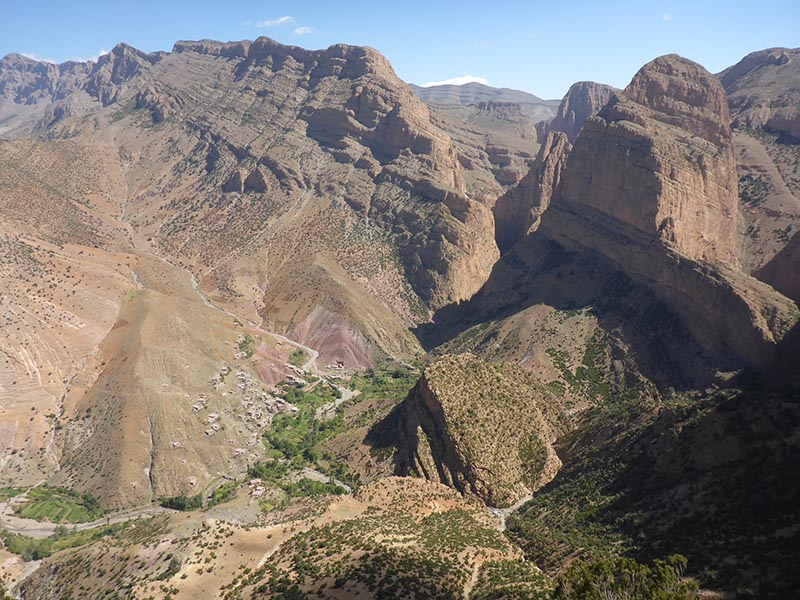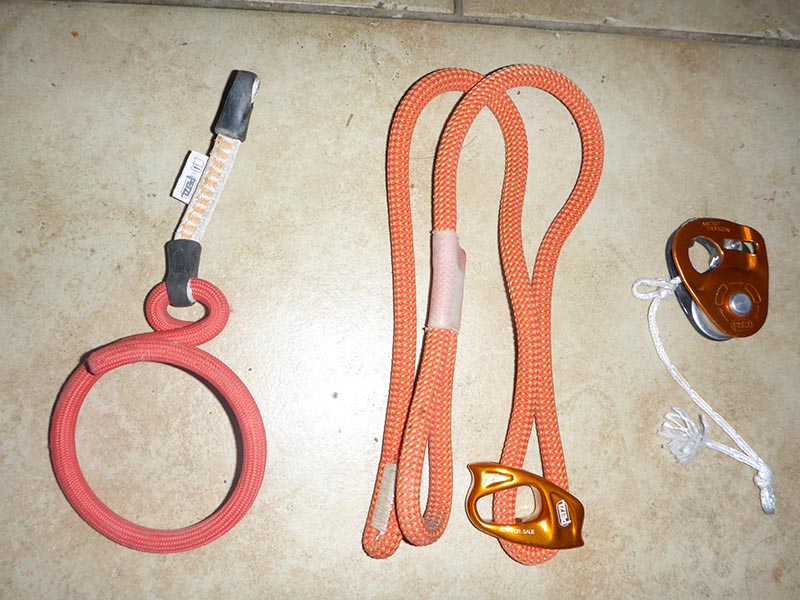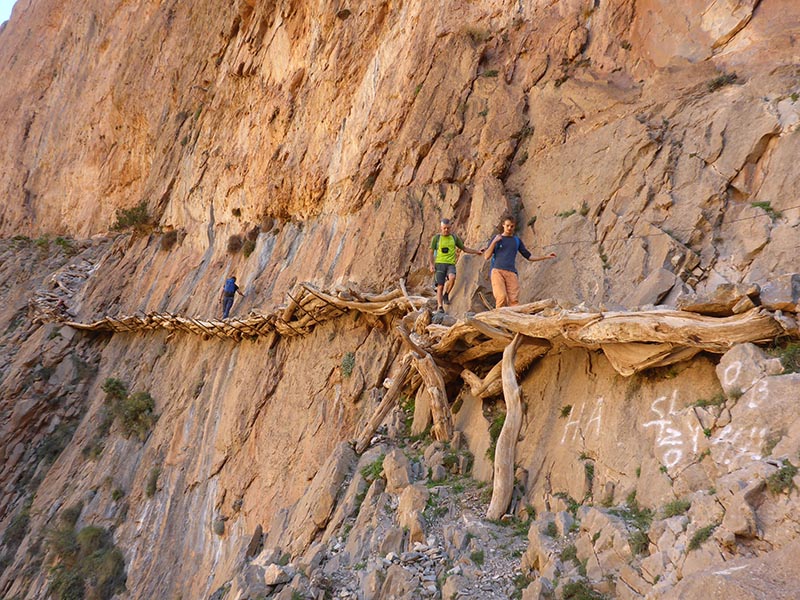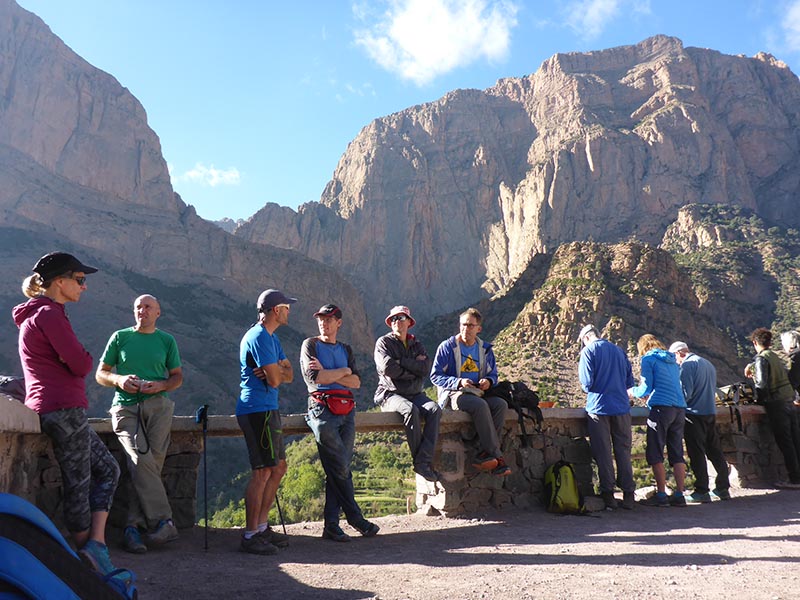I stared down into the gloom through endless vertical scree. This was not a descent route. Hayden stumbled behind me; “is that the way down?”
“No way, that’s death down there for sure”
We’d been frantically wandering around for over an hour now, on a high shoulder of Oujdad, the huge imposing monolith of rock that towers over the village of Taghia in Morroco. Our chosen route of ‘Tout pour Le Club’, 8 pitches and 300m long, had been razor sharp, overly time consuming and under graded. At 7c it should have been testing as opposed to completely exhausting. So this was our first lesson; Taghia grades are tough, to say the least! But we’d topped it at 6pm, relieved to have a comfortable hour and a half of light left, only to find the top was not the top, but in fact the top appeared to be another 3-4 hundred meters above us. Earlier in the day Paul casually informed us “when you get to the top just follow the obvious cairns to the abseil point and then you’re safe and can’t get lost. It’s easy”. Second lesson; don’t trust anyone, particularly Paul. So we staggered around on the huge tilted shoulder, the size of 20 football fields all at 30 degrees and covered in tottering scree that ended abruptly with a 300m drop. We tried going left, following ramp lines till they fizzled into vertical cliff. Tried going right as the angled steepened to unacceptable and the scree seemed to be on the tipping point of no return. Upwards was rock climbing, hundreds of meters, no idea of routes, gear, anything. We were getting un-nerved, It was becoming dark and cold. A night out in some random cave was looking likely. We’d not die, but it would be rubbish!
Picture above has Oujdad on the right, with 'Le Club' climbing the sunny face finishing on the tilted shoulder - no where near the top!
Last minute decision – rap the route we’d just climbed. Bolted belay stations every 40 meters or so. We’d need to find where we had finished, now somewhere far below through loose terrain we’d scrambled through, and descend down the final unprotected 5+ pitch to find the final bolt belay. We had to go NOW, or we’d never make it. Decision made, and we hurried down, taking too many risks, the attraction of a bolt belay and safety drawing us along. Luck was on our side and bolts reflected back in torch beams. A breath of relief, only occasionally cut short with every pull of the rope as the knot snagged its way down. But it ended smoothly; with big thanks to Petzl torches!
Lesson 3 and beyond, of which there are many, but one of the most important is to be fast.
Fast is everything. Routes are long, 500m fairly normal, not even that big. Maybe 15 pitches. Its light at 7am, dark at 7.30pm (in October), with a likely 1.5hr walk back which is best done in the light (and up to 2hr walk-in, which you will plan to do in the dark) so that gives maybe 40 minutes per pitch. That’s for both climbers to climb, and any time messing about at the belay. It’s not that hard to achieve, but isn’t easy either. But the key is really all about before you start.
A/know where your route starts. B/arrive first in the queue.
On the way to climb ‘Le Club’ we met two Polish, who informed us they were on their way to the same route. Thus followed a race, with each team cutting corners to the front, only to walk into dead ends and have to back track. We made it first, utterly shagged and soaking in sweat. They followed, only a pitch or so behind. After we finally made it back to the village for 10pm after our darkness abseil descent, their torches could be seen 1000m above us still on the summit! I think they made it back, but it may have been just in time for a late breakfast at best.
Similarly on the way to climb ‘Les Rivieres Pourpres’ we pulled out all the stops on the complex walk-in to be first, only to fail at the last hurdle when we couldn’t find the start; the pathetic topo being just a line on a bit of paper with dots to show pitches, apparently enough to map 500m of climbing. A Spanish team were hot on our heels, and knew the way, with 100m of grade 3 scrambling they started up while we scratched our heads. We spotted them and sprinted up to arrive joint first, whereupon I racked up in seconds making a spoilt British point that we were going first. After-all they were in a 3, and didn’t look quite up to the job of 7b+, and also they were Spanish, so more likely to be relaxed. As it turned out they followed us up closely, saving time by pulling on the draws when the going got tough. They were right behind as we topped out at 6pm in the rain, but ended up returning many many hours after us having struggled with slippy wet gullies of death in the dark.
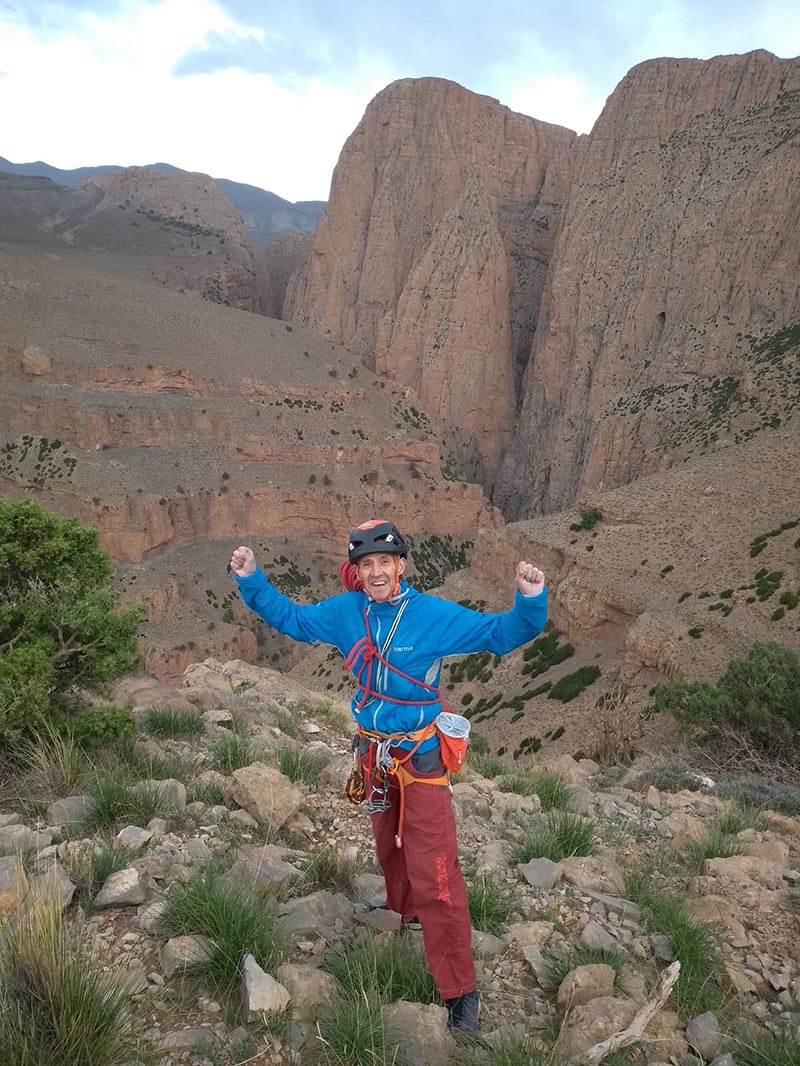
The summit after climbing 'Les Rivieres'
So a quick start is in order. But knowing the terrain is more than useful. After what seemed like endless slab climbing on ‘Le Club’ we opted for a rest day to rest our battered feet and went for a seven hour walk, constantly drawn on by incredible scenery that went on forever. Huge canyons, massive walls, vast high plains. Passing by our intended descent from ‘Le Club’ it was blatantly obvious there was absolutely no chance we’d have made it. Even in the light with half a day to spare there was no chance. Basically we were totally unprepared and underknowledged. The scale of this place is vast. It’s not like topping out at Stanage, or even Cloggy for that matter.
‘La Riviere’ could be a contender for the best multi-pitch sport route in the world. Perfect rock, really interesting and sustained climbing on a vast open face with sublime views all the way. This is what I’d expected from Taghia. Maybe this is one of the finest multi-pitch venues in the world. There are so many routes, with clearly so much potential. But still, not every route is a classic. Choose your route and your style. By the time we did this route we’d just about sorted our ‘system’; which is also key to avoiding getting stuck out in the dark. Just 10 minutes of faffing around per pitch on a 15 pitch route will cost you two and a half hours. Tangled ropes, poor hauling and changing footwear are the usual culprits, alongside getting stuck on hard moves and having to hand over your lead to your mate. We kind of made up our system, but some stuff that really worked for us:-
Hauling. Long routes with walk-offs need a bag full of junk. On easier routes each climber can carry their own approach shoes, waterproof, water and snack clipped to their harness, but if you are really pushing your grade then this heap of stuff is a pain, and don’t expect the second to want to carry it either. Hauling is easy. The leader takes a ‘tag-line’ which is not clipped into the quickdraws. In our case this was an 8mm half rope, essential for abseiling, and not that heavy. The end of the tag-line is already prepared through a Microtraxion, a totally essential bit of kit, which is clipped straight into the belay as soon as the leader arrives. Before the second climbs the slack in the tag-line is taken in until the bag is hanging. The leader now sorts out belaying the second and at the same time occasionally pulls up the bag when there is a free moment. Note – a small haul bag is useful, unless you don’t mind your lovely rucksack getting completely trashed!
Belaying. We used one Grigri and one Petzl Reverso (though we had 2 Reversos, one each for abseiling). Belaying the leader with a Grigri is so much better. The second brings it up and passes it over and can immediately be put on Grigri and even held on this device while re-racking. The Grigri also makes it much easier for belayer to grab a snack or drink. The leader uses a Reverso to bring up the second, or similar device with Guide Mode. What an invention that is! Just make sure you put the device on right, and you can then belay with much less effort and not have to worry about holding his weight while he hangs on the rope trying to figure out the crux.
Slick stance. Two other bits of kit were simply awesome. The first being the Petzl Connect-Adjust, which is simply brilliant and puts you in the right place with instant adjustment. Forget slings and daisy-chains, this is just so much better! Second was a ‘rope-hook’, mine being a simple coil thing that I’ve had for years and not used but now realise makes multipitch life miles better, with at least one of your ropes neatly hanging to your side as opposed to tangling up in your lap.
Also I found a pair of thick socks were great. You’ll want to take off your shoes after each pitch (don’t drop them) and the socks make it much more comfy on the spiky rock, not to mention keeping your feet warm when it gets windy (which it will).
essential kit!
For me the best route was on the North Face of Oujdad. Not an established classic and taken on as a kind of ‘rest day’ before something harder. At around 7a+/7b/6c+/7a+/7a/7a+/6c/7b+ ish, it should have cruised, though in reality was completely desperate with the 7b pitch being my hardest lead of the trip (so harder than a few 8a’s and 7c+’s). It was so good because it was a real adventure. OK its mainly bolted, but rather sportingly, and combined with some loose rock, tricky route finding, dirty hand holds, the odd peg and bit of tat, way out there positions and a fantastic line, this was exactly what I was after; an adventure in the mountains.
And this kind of sums up the place. Adventure. Even the simple lack of phone reception and internet making us feel isolated with our addiction to technology. Amazing to think that not long ago my correspondence with friends was only by post! Days are filled with being out there doing stuff; you leave in the dark at 6.30, arrive back in the dark, eat, chat, sleep. So simple and so exactly what we signed up for! Perhaps my best day wasn’t even climbing. With my partner recovering I set off walking, taking a vaguely planned route from gained understanding of how the place fitted together. I walked for hours and hours, through huge canyons, wide open valleys with trickling streams and open plains. I picked a line through rock bands, spotting ramp-lines from a mile or so away and wondering if they’d work. There were no paths, no cairns, no trace of human life, just myself in the sunshine picking a way through nature. I was out 10 hours with 2000m of up and down. The views were immense, the feeling of isolation and peace overwhelming, and its perhaps this day more than any other that is making me so desperate to go back!
Taghia Beta
Marrakech Airport to the road end in the village of Zaouiat Ahansal is about 5 hours.
There are supermarkets on the way near Marrakech where you can grab supplies if you need any.
The walk from Zaouiat Ahansal takes about 2.5 hours. (Donkeys carry your big bag) It’s fairly flat really. Be prepared with full waterproofs just in case, plus the stuff in your bag protected from the wet too – you’ll not be happy to arrive exhausted to find your down jacket thoroughly soaked!
There is no road in. One is being built, but it doesn’t look like it will be finished any time soon!
Stay at Youssef’s place or Said’s place. Both offer rooms and evening meal and breakfast for between 12 and 14 euros. Said’s is slightly more favoured by climbers. Youssef’s has a better view up on the hillside. Said’s has pancakes for breakfast, Youssef sometimes plays live music.
When sorting your accommodation in advance they will also sort your taxi from airport, and a donkey to carry your kit up to Taghia.
Food is good! Tales of poor food can be ignored. For sure it’s simple but it’s tasty and usually more than ample. Breakfast is bread and jam/honey. Take your own cereal if you want. Evening is usually tagine and pretty good. Fruit for desert so maybe bring some chocolate.
Take all your own hill food: Mars bars, oat cakes, nuts, dried fruit, chocolate, cheese; whatever you want. You can’t really buy anything in Taghia. You can pinch some bread from Breakfast.
A bottle of spirits is most advisable! Get one in the duty free on your way through.
Water – Taghia is built around an amazing spring bursting from the cliff, where pure fresh water is available for all. It’s about 10 minutes from the village. Pipes carry this water to the village. I guess there is potential for contamination along the way. Some people purified water, some didn’t bother. Some collected from the spring. Not many people got sick.
With an early flight from the UK, arriving at 10 or 11am into Marrakech you can expect to arrive in Taghia the same day. On the return it will be pushing it in a day, and is probably best to have a morning flight and spend the night in Marrakech, which actually is an experience not to be missed. The city centre is buzzing, with all kinds of spectacles to watch, amazing food to be had and tourist junk to spend the last of your cash.
Payment for accommodation and donkey and taxi can be in euros. Local currency is useful for local food and any bits and bobs. I only had about £40 worth of Dirham (from airport cash machine) and this was easily enough.
UKC article here fills in the gaps
https://www.ukclimbing.com/articles/destinations/taghia_morocco-2008

